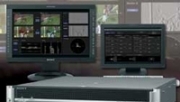Sony releases details of 3-D processor box

Sony has released more details about its 3-D processor box, the MPE-200, to be used at the World Cup. According to Andy Hotten, Sony group product manager, the MPE-200 is designed to give outside broadcasters “the ability to produce quality 3-D without necessarily the expense and additional time required for use of fully motorized rigs.”
The box takes in two video streams along with lens metadata from camera left and right outputs and provides electronic picture correction. It can correct horizontal and vertical image shift, toe-in correction, tilt and rotation, zoom synchronization, color misalignment and any inversions caused by the use of mirror rigs.
“The box calibrates the optical centers of the two lenses throughout the entire zoom range,” Hotten said. “After alignment, a convergence operator can set the required interaxial distance of the rig, and the software will calculate and correct for any misalignment during production. The stereographer can also monitor and adjust the signals to ensure they do not go beyond the depth budget boundaries.”
“Via the integration of Sony HDC studio cameras,” he added, “the box can read the lens zoom information and, thus, dynamically correct for any misalignments throughout the total zoom range.”
The MPE-200 is currently being tested to work with Canon lenses during the World Cup, but Fujinon lenses are likely to be supported as well. Further versions of the technology will be able to control the rigs themselves. “Ideally, the more correction you can do at the rig, the less work the box has to do,” Hotten said.
The 3-D box will not currently work with 3ality rigs, but Hotten said Sony is investigating this, and there’s no reason why it won’t be able to at some point. The product combines hardware based on the Sony Cell processor found in the PS3 plus 3-D software, dubbed MPES3D1. Later versions of the software are also planned to deliver enhanced graphics manipulation and digital effects. The processor includes a histogram displaying how much convergence is being pulled and also provides a variety of 3-D monitoring methods, including 50 percent mix, above/below, anaglyph, difference and side by side.
Up to 16 of the devices will be deployed by HBS to cover the tournament, fitted to trucks owned by UK outside broadcaster Telegenic and one from French OB supplier AMP Visual TV. The product has been shipping since NAB and has already seen use to cover the US vs. Germany IIHF World Championship match in Gelsenkirchen, Germany, in May. Plazamedia produced the game for Constantin Sport Medien with 3-D specialists TopVision.
Get the TV Tech Newsletter
The professional video industry's #1 source for news, trends and product and tech information. Sign up below.
Adrian Pennington is a journalist specialising in film and TV production. His work has appeared in The Guardian, RTS Television, Variety, British Cinematographer, Premiere and The Hollywood Reporter. Adrian has edited several publications, co-written a book on stereoscopic 3D and is copywriter of marketing materials for the industry. Follow him @pennington1

